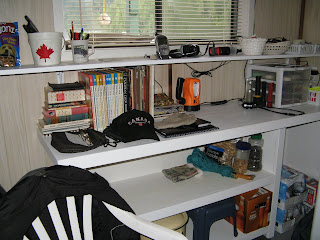
Our search for a
new propane stove was fairly inexpensive and easy because houses sometimes use gas. Refrigerators are a whole different animal. Home refrigerators are almost exclusively electric.

Propane refrigerators are most often found in small sizes for trailers and RVs. When John built our cabin, he got this used 8 cubic foot model out of an old trailer. It served us well for over ten years, but we yearned for more space in both the freezer and fridge.

We looked online and in several stores, but the RV models are too small. They also aren't finished on the outside because they are designed to fit into a modular unit. At
Rona here in Powell River, they carry
Unique brand propane refrigerators. They are made in Ontario, Canada, but are distributed throughout North America. It's a home-style refrigerator, but runs on propane. And we could get it in a 13 cubic foot model (they go all the way up to a massive 18).

Because it is larger than the space under the stairs, we changed the location to the end of the sink, a good spot for kitchen use. It's also a good place because we (John actually) had to install a new propane line from our tanks on the other side of the wall.
Look at all that space in the freezer, fridge and doors. It fills up fast, but there's plenty of room for frozen meats and fresh foods.
Our
Unique refrigerator lives up to its name.
Propane refrigerators work a little
different than electric ones. I don't profess to understand the process, but electric models use a gas called tetrafluoroethane, a motor, a compressor and coils to contain the gas/liquid cooling process.

A propane refrigerator has a few more steps including a propane flame powered generator to create ammonia gas, a separator, a condenser, an evaporator (where the cooling occurs), and an absorber. It's a closed, continuous-cycle system as long as the propane is burning.

Here you can see the condenser fins that are part of the cooling process at the back of our top refrigerator shelf.
Propane consumption for our 13 cubic foot model is 1.4 pounds per day at maximum cooling.

We have ours set lower. Where we live, a pound costs $1.00. We are still in the process of calculating our actual consumption. We have three 40 pound tanks, so we can run our refrigerator full time (and stove and lights) for over a month without going back to town for refills.

Because burning propane indoors might cause carbon monoxide emissions, the refrigerator must either be vented to the outside or have a monitoring device installed. We opted for the monitoring device. We just have to be careful that the 9 volt battery inside is charged. Otherwise, the propane will be shut off and that would be a bad thing!
If you are in the market for a home-style propane refrigerator take a look. As they say:
It's not just a fridge.
It's Unique! -- Margy
 Last week you saw the completion of my new bathroom. I was so excited, I didn't know which to use first - the toilet or the tub. Well, nature took care of that decision for me. On my first night back, I used the wood stove to heat four big pots of water. What a luxurious feeling to sit back and have a hot soak.
Last week you saw the completion of my new bathroom. I was so excited, I didn't know which to use first - the toilet or the tub. Well, nature took care of that decision for me. On my first night back, I used the wood stove to heat four big pots of water. What a luxurious feeling to sit back and have a hot soak. The next thing was to put together the bargain pantry I found at Walmart. It was originally $89, but on sale for just $49. It's made of MDF (medium-density fiberboard), but it's quite sturdy. And it came in a white finish that is perfect for my new room.
The next thing was to put together the bargain pantry I found at Walmart. It was originally $89, but on sale for just $49. It's made of MDF (medium-density fiberboard), but it's quite sturdy. And it came in a white finish that is perfect for my new room. Up on top, Wayne has space for his model Coast Guard Cutter that has been displaced because of our kitchen remodel. I think it looks good here, giving a spot of colour against the light walls. What do you think? -- Margy
Up on top, Wayne has space for his model Coast Guard Cutter that has been displaced because of our kitchen remodel. I think it looks good here, giving a spot of colour against the light walls. What do you think? -- Margy















































